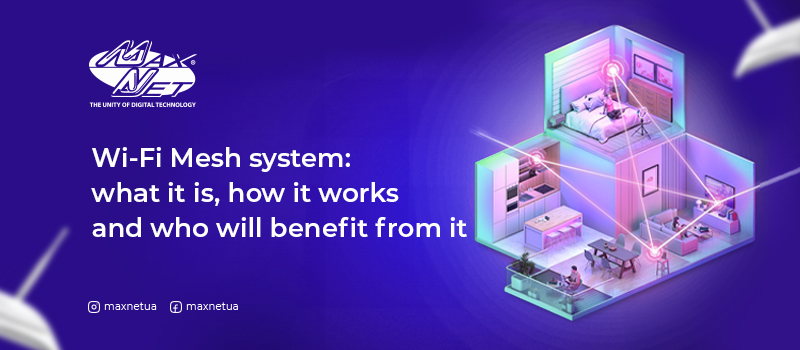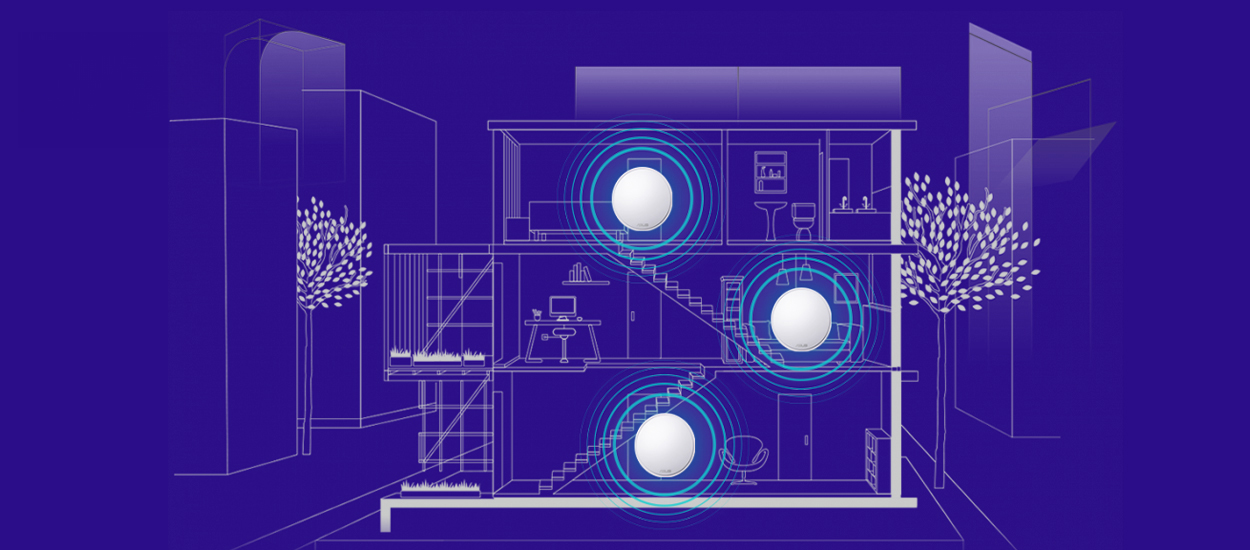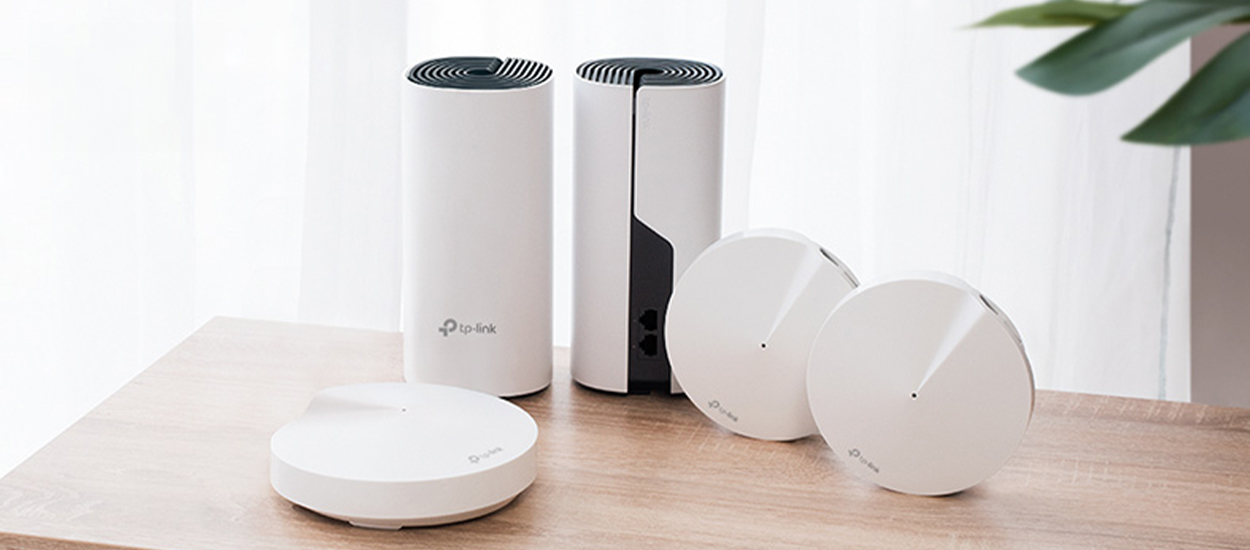
What to do if you have poor or incomplete Wi-Fi coverage at home, and it is difficult to install and configure an additional router to create another Wi-Fi network yourself? There is an alternative solution — to organise one powerful but easy to set up and manage home Wi-Fi Mesh-system for the whole flat. We tell you about it in detail in this article.
What is Wi-Fi Mesh?
Mesh Wi-Fi is the name given to a home Wi-Fi system that provides a stable, high-speed Wi-Fi connection with a wide range of coverage for the devices it covers.
In such a system, only one device is connected to the Internet, which is the main device (the main router or gateway). And other devices (nodes or modules, of which there can be about ten) are responsible for receiving and relaying the gateway's signal within the network. Each of these modules works independently of the others, and together they form a daisy chain in a single network.
Only electrical outlets are needed to power the nodes (and the more the better). And in case of adding or removing modules, the Mesh system does not need to be reconfigured — it changes its configuration on its own.
Principle of Mesh systems operation
All nodes in a seamless network communicate with each other to ensure a reliable signal even at the furthest points of the Mesh system from the router. For this purpose, each transmitter is equipped with an antenna unit, the elements of which provide data transmission for different types of equipment (PCs, game consoles, TV consoles, etc.), wireless communication via Bluetooth and a service communication channel. And to set up the created Mesh Wi-Fi system, it is enough to use the mobile application installed on a smartphone.
Among Mesh kits there are dual-band, which operate on 2 channels (2.4 and 5 GHz) and tri-band respectively with 3 channels (two user 2.4 and 5 GHz and one service 5 GHz). Budget dual-band Mesh kits are definitely better than conventional single-channel routers. Due to the presence of a third channel, tri-band Mesh kits are more expensive. But if you need to connect a TV set or other appliances to the Internet via twisted pair, advanced models with USB-connector and more than two LAN-ports will cope with this task.
Who would benefit from a Mesh network?
A home Wi-Fi Mesh system will suit residents of:
- Single-storey houses or rectangular-shaped flats. In this type of layout, one device from the kit is placed in the middle of the dwelling and the other two devices are placed closer to the edges.

- Two-storey or three-storey houses with a total area of 150-200 square metres. In addition, the walls in such houses can be made of brick or concrete — these materials don’t hinder the signal propagation of wireless mesh network, while they become an obstacle for Wi-Fi signal of routers. In such a housing layout, at least one node is installed on each floor.

Features of Mesh Wi-Fi
At first glance, it may seem that Mesh Wi-Fi functionally resembles Wi-Fi signal amplifiers (repeaters). But in fact there are a number of differences between them:
- Mesh Wi-Fi signal is faster and more efficient than the signal of Wi-Fi amplifiers.
- Each module in a Wi-Fi Mesh system essentially acts as a router, while repeaters only duplicate the signal of the main router.
- When using Wi-Fi amplifiers, a new network is connected to maintain a stable signal when you are far away from the router, whereas the Mesh system provides a high-speed Wi-Fi connection with a wide coverage area.
With the above in mind, the key features of the Wi-Fi Mesh system are as follows:
- One name and one password. Each new module is connected to the mesh home Wi-Fi network using one name and one password.
- Adaptive routing. Through its use, Mesh Wi-Fi routers automatically detect the frequency range and select the best route for transmission, which helps to maintain consistently maximum speeds.
- Seamless roaming. This feature allows seamless switching from one Mesh node to another, so you can watch streaming video or make video calls anywhere in your home without disrupting your connection.
- Self-healing. If one node in your Mesh Wi-Fi fails, the network automatically reroutes traffic to keep the signal flowing.
Advantages and disadvantages of Mesh Wi-Fi
Some of the obvious advantages of Mesh Wi-Fi include the following:
- High data transmission speed due to the multi-channel system.
- Stable Internet signal when its source changes in case the device is moved around the house.
- Ability of advanced Mesh models to integrate into Smart Home systems.
- No need to set up the modules: just plug in the power and tap a few times on the smartphone app.
- Ability for Mesh modules to select channels and change settings to maximise data transfer rates.
- Stable functioning of the wireless network in case one of the modules fails.
- Availability of parental control and content filtering functions, which will be useful when setting up an access point in a child's room.
- Ability to integrate Mesh-devices into the existing home network with the possibility of access points interaction from different lines of the same manufacturer.
- Attractive design of Mesh modules, which allows them to fit well into the home interior.

But, besides advantages, Mesh Wi-Fi has some disadvantages:
- Limited functionality of Mesh network elements in contrast to classic routers, which offer a greater choice of settings.
- Fewer LAN ports on devices in most Mesh kits (1 WAN and 1-3 LAN ports compared to 1-2 USB sockets and 4 LAN ports on most router models).
- Higher price of Mesh modules compared to the price of conventional routers with similar specifications.
Yes, Mesh systems are not perfect. However, they are popular with consumers because of their ease of creation, ease of use and efficiency. So we should expect to see improvements in seamless traffic transfer over time.
Еще комментарии








Роман
19.04.2024
3
0
Reply